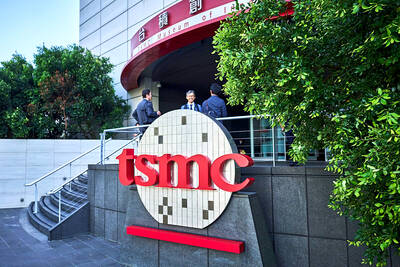E-book readers are lightweight and use little power, but most have a distinct disadvantage to colorful tablet computers: their black-and-white displays.
But today at the FPD International trade show in Tokyo, a Chinese company will announce that it will be the first to sell a color display using technology from E Ink, whose black-and-white displays are used in 90 percent of the world’s e-readers, including the Amazon Kindle, Sony Readers and the Nook from Barnes & Noble.
While Barnes & Noble recently announced a color Nook and the Apple iPad has a color screen, both devices use LCD, the technology found in televisions and monitors. The first color e-reader from Beijing-based Hanvon Technology (漢王科技) has an E Ink display.
“Color is the next logical step for E Ink,” said Vinita Jakhanwal, an analyst at iSuppli. “Every display you see, whether it’s a TV or a cellphone, is in color.”
Jennifer Colegrove, director of display technologies at DisplaySearch, said it was a milestone moment.
“This is a very important development,” Colegrove said. “It will bring e-readers to a higher level.”
E Ink screens have two advantages over LCD — they use far less battery power and they are readable in the glare of direct sunlight.
However, the new color E Ink display, while an important technological breakthrough, is not as sharp and colorful as LCD. Unlike an LCD screen, the colors are muted, as if one were looking at a faded color photograph. In addition, E Ink cannot handle full-motion video. At best, it can show simple animations.
These are reasons Amazon, Sony and the other major e-reader makers are not yet embracing it. Amazon says it will offer color E Ink when it is ready; the company sees color as useful in cookbooks and children’s books and it offers these books in color through its Kindle application for LCD devices. Sony is also taking a wait-and-see approach.
“On a list of things that people want in e-readers, color always comes up,” said Steve Haber, president of Sony’s digital reading business division. “There’s no question that color is extremely logical, but it has to be vibrant color. We’re not willing to give up the true black-and-white reading experience.”
But Sriram Peruvemba, an E Ink vice president, is not upset by the reluctance of the market leaders to adopt his color technology.
“I’m convinced that a lot of times it takes one company to prove the market,” Peruvemba said.
While barely known in the US, Hanvon is the largest seller of e-readers in China. Its founder and chairman, Liu Yingjian (劉迎建), said Hanvon has a 78 percent share of the Chinese market.
Hanvon’s first product using a 9.68-inch color touch screen will be available in March in China, starting at about US$440. The price is less than an iPad in China, which sells for about US$590. It will be positioned as a business product, with WiFi and 3G wireless connectivity.
“It’s possible that we’ll sell this in the US as well,” Liu said.
Hanvon sells other products, like tablets and e-readers, to the US online and through Fry’s, a regional electronics chain.
E Ink, based in Cambridge, Massachusetts, was bought by Prime View International of Taiwan last year and was recently renamed E Ink Holdings (元太科技).
To create the color image, E Ink uses its standard black-and-white display overlaid with a color filter. As a result, battery life is the same as its black-and-white cousins, measured in weeks rather than hours, as with the iPad. The color model from Hanvon can be easily read in bright light, although the color filter does reduce the brightness.
The Hanvon e-reader is not intended to be a multifunctional rival to the iPad, but rather a dedicated reading device, like the Kindle.
Colegrove said these types of lower-cost products should continue to gain market share, growing from 4 million units sold worldwide last year to 14 million units by next year.
At the same time, slate-type devices like the iPad will increase from 1 million last year to 40 million next year, she predicted.
“Color is absolutely critical for E Ink,” said James McQuivey, an analyst at Forrester Research. “Without it, they’ll either be replaced by LCD displays or other competitors.”

With an approval rating of just two percent, Peruvian President Dina Boluarte might be the world’s most unpopular leader, according to pollsters. Protests greeted her rise to power 29 months ago, and have marked her entire term — joined by assorted scandals, investigations, controversies and a surge in gang violence. The 63-year-old is the target of a dozen probes, including for her alleged failure to declare gifts of luxury jewels and watches, a scandal inevitably dubbed “Rolexgate.” She is also under the microscope for a two-week undeclared absence for nose surgery — which she insists was medical, not cosmetic — and is

CAUTIOUS RECOVERY: While the manufacturing sector returned to growth amid the US-China trade truce, firms remain wary as uncertainty clouds the outlook, the CIER said The local manufacturing sector returned to expansion last month, as the official purchasing managers’ index (PMI) rose 2.1 points to 51.0, driven by a temporary easing in US-China trade tensions, the Chung-Hua Institution for Economic Research (CIER, 中華經濟研究院) said yesterday. The PMI gauges the health of the manufacturing industry, with readings above 50 indicating expansion and those below 50 signaling contraction. “Firms are not as pessimistic as they were in April, but they remain far from optimistic,” CIER president Lien Hsien-ming (連賢明) said at a news conference. The full impact of US tariff decisions is unlikely to become clear until later this month

GROWING CONCERN: Some senior Trump administration officials opposed the UAE expansion over fears that another TSMC project could jeopardize its US investment Taiwan Semiconductor Manufacturing Co (TSMC, 台積電) is evaluating building an advanced production facility in the United Arab Emirates (UAE) and has discussed the possibility with officials in US President Donald Trump’s administration, people familiar with the matter said, in a potentially major bet on the Middle East that would only come to fruition with Washington’s approval. The company has had multiple meetings in the past few months with US Special Envoy to the Middle East Steve Witkoff and officials from MGX, an influential investment vehicle overseen by the UAE president’s brother, the people said. The conversations are a continuation of talks that

CHIP DUTIES: TSMC said it voiced its concerns to Washington about tariffs, telling the US commerce department that it wants ‘fair treatment’ to protect its competitiveness Taiwan Semiconductor Manufacturing Co (TSMC, 台積電) yesterday reiterated robust business prospects for this year as strong artificial intelligence (AI) chip demand from Nvidia Corp and other customers would absorb the impacts of US tariffs. “The impact of tariffs would be indirect, as the custom tax is the importers’ responsibility, not the exporters,” TSMC chairman and chief executive officer C.C. Wei (魏哲家) said at the chipmaker’s annual shareholders’ meeting in Hsinchu City. TSMC’s business could be affected if people become reluctant to buy electronics due to inflated prices, Wei said. In addition, the chipmaker has voiced its concern to the US Department of Commerce